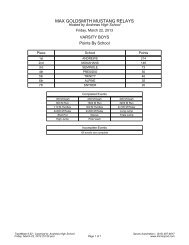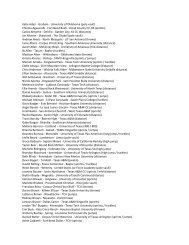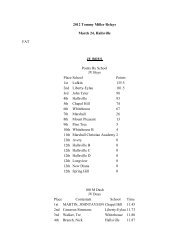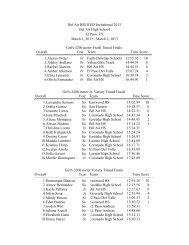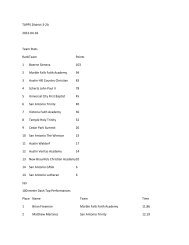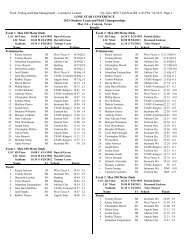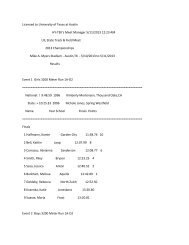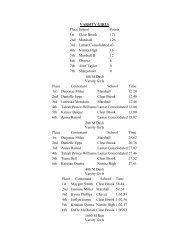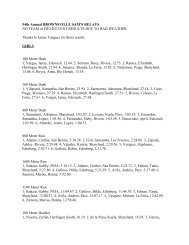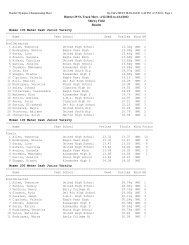1. PAGES 1-35 - Texas Track & Field Coaches Association
1. PAGES 1-35 - Texas Track & Field Coaches Association
1. PAGES 1-35 - Texas Track & Field Coaches Association
Create successful ePaper yourself
Turn your PDF publications into a flip-book with our unique Google optimized e-Paper software.
on their short legs and large heads!<br />
Running speed increases during childhood because<br />
stride length increases. The stride increases as the legs<br />
grow longer and stronger and as the pattern becomes<br />
more efficient. As children progress, they take longer<br />
steps or strides and stay in the air longer during flight<br />
phase. When young children are asked to run faster, they<br />
generally take quicker steps—often in place. Rather than<br />
saying “Run faster,” coaches should say, “Take bigger<br />
steps.” The fastest runners use their arms to pull themselves<br />
forward. The arms move in opposition, with the<br />
upper arm (humorous) driving forward forcefully. In<br />
young children the arms may be stationary or may flail in<br />
KIRBY LEE PHOTOGRAPH<br />
no particular pattern. As skill increases, the arms begin<br />
to rotate in opposition, but this movement is generated<br />
by a twisting of the spin rather than by conscious movement<br />
of the humorous.<br />
Skills change systematically for children from 2 years of<br />
age through elementary school. For example, you would<br />
expect to see a 2-year old run with arms high, extended,<br />
and straight (picture Frankenstein’s walking), feet shoulder-width<br />
apart, and a short, flat-footed step. You would<br />
not expect to see this kind of movement in an adolescent<br />
or an adult. Why do these skills change? Some change is<br />
caused by growth. For example, as legs get relatively<br />
longer, the stride length increases. Similarly, as relative<br />
head size decreases balance is less of a problem. Also, the<br />
central nervous system is maturing with increase in<br />
synapses and better integration of information. These<br />
allow better motor control with maturation. The biological<br />
changes work with practice to improve the execution<br />
of skills. The developmentally appropriate track and field<br />
program is designed to recognize the individual differences<br />
in rate of change in the fundamental skills and to<br />
capitalize on the consistency of the order of these<br />
changes. <strong>Coaches</strong> should plan for the average and then<br />
accommodate variation by individualizing up or down<br />
within each practice.<br />
The body makes two major adjustments during aerobic<br />
exercise such as running. First, muscles do their work<br />
during exercise by using fuel (food) and oxygen. The<br />
more intense the work is, the more the body uses oxygen<br />
and fuel. Generally, respiration and heart rate increase<br />
with the intensity of exercise. At some point, the circulatory<br />
system can no longer keep up in delivering oxygen<br />
and removing waste. Fatigue sets in quickly at that point,<br />
and work must be stopped or substantially reduced.<br />
The second effect of exercise is the production of heat.<br />
The body dissipates some heat by breathing but removes<br />
most of it by sweating. The circulatory system increases<br />
blood flow to the skin, and the heat is lost by radiation<br />
and evaporation of sweat. <strong>Coaches</strong> should be conscious<br />
of this process, particularly during hot and dry weather,<br />
when excessive sweating and evaporation may produce a<br />
loss in total body fluid that can result in dehydration.<br />
People of all ages are susceptible to dehydration. Always<br />
permit children to drink as much water as they want to<br />
during and after training. Water is as good a fluid replacement<br />
as any of the advertised commercial products. The<br />
USDA warns that children do not drink enough water<br />
regardless of whether they are exercising, so encouraging<br />
children to drink water meets the demands of training<br />
and a more general nutritional need.<br />
Children and adults handle heat and oxygen producing<br />
differently during training. Children have higher resting<br />
heart rates than adults; at rest, children’s hearts are work-<br />
AUGUST 2011 techniques 17



